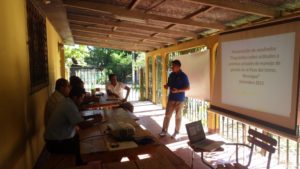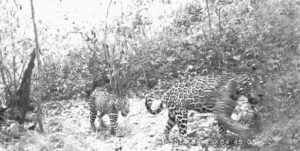As a conservation biologist, one of the most important parts of my job is making trips to the field so that I can better design and manage the many scientific projects that Paso Pacífico’s local employees work on. Others imagine that I spend most of these trips walking up rivers to survey frogs, scrambling through jungle to follow monkeys, or capturing bats on the crater edge of and active volcano – and these are all things that I had the pleasure to do this past December! However, without a doubt the most important parts of these trips are not seeing plants and animals, but rather talking to the people who shape the landscapes where this unique biodiversity lives.
At Paso Pacifico, one of our core tenants is to partner with local communities to meet conservation goals together. Although it may take longer to meet a goal, it also means that we can be much more confident that our actions will have a long-term result, because local populations don’t just accept our actions – they help design them!
During my last trip, I worked to put this into practice by spending several days conversing with local ranchers to talk about jaguar conservation. As the forests have recovered and expanded in the Paso del Istmo, jaguars have started to recolonize the area; unfortunately, their return has led to conflicts with local farmers, since the large cats have started predating on people’s horses and cows. Potential solutions to the problems are diverse, but no one plan works everywhere – each location has different social and ecological factors interacting.

To develop a program to mitigate jaguar-rancher conflict, we began by surveying 50 local farmers on their livestock management practices, including 20 farmers who were affected by jaguar predation on livestock in 2014. We found a clear pattern – the smallest, poorest farmers were most vulnerable. Farmers who suffered losses of livestock to jaguars were far more likely to have smaller properties and herds, and far less likely to have infrastructure like corrals and fences.
At first glance, the obvious solution would be to tell people to construct fences and corrals – but such a superficial approach would overlook the financial and social contexts in which people live. Firstly, these poor farmers generally lack the capital to build fences. More importantly, even with fencing, many farmers would still let livestock roam in forests at times due to a lack of natural grass in the dry season.
In December 2015, I conducted a series of workshops with local farmers to present our results and discuss actions they thought would help prevent jaguar predation. Many farmers are enthusiastic about corrals and fences but need financial support for such improvements. By working hand-in-hand with these farmers, Paso Pacífico has a tremendous opportunity to improve the conservation value of pastures by promoting the establishment of living fencerows and adoption of eco-friendly silvopastoral systems that incorporate tree cover. Farmers also highlighted the importance of Paso Pacífico’s communication network in ranching communities to spread the word when jaguars are in the area and farmers need to take extra care to guard animals.

Although the arrival of jaguars in the Paso del Istmo initially brought conflict and fear, their effects led us to establish relationships with a host of new communities. Paso Pacífico’s partnerships with local ranchers will take several years to develop; however, helping farmers adopt sustainable, eco-friendly ranching will have a transformative effect not only for local wildlife, but also for local livelihoods.
By Kimberly Williams-Guillén, Ph.D.
Director of Conservation Science
Paso Pacífico